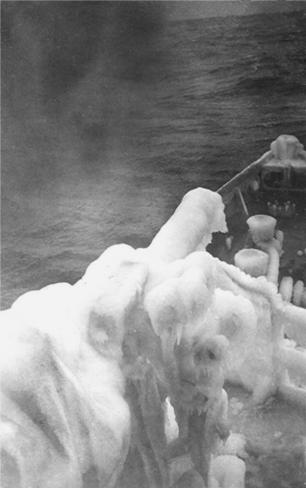
Christmas Dinner aboard Sarsi. Weather station Commander on left, unidentified man on right.
From the photo collection of CDR Richard E Hall, USN. Furnished by Jason Keller.
The Russian Cruise
As part of the plan for the invasion of Japan, the Allies established weather stations to monitor conditions in the approaches to the Japanese mainland. One such station was at Petropavlovsk, on the Siberian Kamchatka peninsula of Russia. The USS Bennett DD-473 transported men and equipment in to construct the station in Sep 1945.
After some mis-coordination, communication was established with the station in mid Oct. At first, the station personnel were expected to live in tents, but with temperatures ranging from -38F to 0F, soon Quonset huts were constructed by Seabees. The Soviets quickly surrounded the installation with barbed wire to contain the "Amerikanskis".
On 5 Dec 1945, Soviet Army Chief of Staff Ivanov requested of US Navy Admiral Chester Nimitz that the US bases be closed by 15 Dec. Orders were received at Petropavlovsk on 11 Dec. Approximately sixty personnel and eighty tons of equipment were in need of being moved immediately. The USS Sarsi was dispatched from her base at Adak to undertake the task of evacuating the base.

Among the crew who were aboard on this mission was Sonarman 1st Class Al Lidert, and Ship's Cook 1st Class Gil Corey. Lidert was a "planker". He had been of the initial commissioning crew of Sarsi. Corey had been ordered aboard as Temporary Additional Duty from his shore station at Adak. Sarsi's senior cook had just left the ship for discharge.
When Sarsi arrived at Petropavlovsk, some of the crew had visions of liberty, vodka and debauchery. According to Corey, "...none of that came to pass. The population had been warned not to associate and there was no infrastructure of independent profit making business there." A similar situation was encountered at Khabarovsk, where another weather station was being evacuated by the USS Starr. Starr's crew was confined to their ship by the Soviets. The mood was tense. The Cold War between Russia and the US was already in full swing. Indeed, Lidert related, "...we POs who stood the Gangway Watch were told to watch for anyone sneaking aboard at night. We didn't relish the idea of a bomb being placed among the Depth Charges on deck. I almost shot one of our Signalmen one night."
After loading 39 personnel and gov't equipment aboard, Sarsi set out for Adak. Enroute, the ship encountered an ice storm. Lidert said, "... we went thru a weather front where the temperature dropped like a rock in a sock. We had to stop and the whole crew started to chop ice off of everything. The ship had been pronounced as unstable. We were carrying extra weight that we picked up at the weather station in Russia, like Diesel generators, sundry supplies, a Jeep, a Weasel Half- Track, and tons of goodies. What we didn't take with us was soaked with gasoline and diesel oil and burned at the base." Corey described his experience with the storm this way. "When the ship would roll it would take a long time to right itself. The officers were VERY worried as was this writer. We finally got some good weather where it was safe to go on deck and the skipper called all hands to break ice. The captain took the helm. He left one snipe to handle the throttle in the engine room and me in the galley while all hands, officers included, went topside to lighten the load of ice."


Christmas Dinner aboard Sarsi. Weather station Commander on left, unidentified man on right.
From the photo collection of CDR Richard E Hall, USN. Furnished by Jason Keller.
What happened next must have been one of the bold moves of the Aleutian Campaign. Corey relates, "As we bypassed Adak on the way stateside, Third Fleet headquarters tried to make us go into Adak where they planned to transship the meteorology crew home. Our skipper claimed he had superseding orders. So we went Stateside!"
Lidert said they went to Seattle where Sarsi went into drydock after
unloading the gear from the weather station. During the drydocking,
the sonar gear and depth charge racks were removed from the ship,
never to be remounted. Both Al Lidert and Gil Corey were discharged
from the Navy in Mar 1946. It was their last adventure of WWII.
Sources: PLANNED INVASION OF JAPAN:1945 The Siberian Weather
Advantage - H. S. Yoder, Jr.
THE HISTORY OF THE USS BENNETT DD473,
George E. Roberts, Jr.
Personal Recollections of Albert W. Lidert and Gilbert W.
Corey.
Also thanks to Jason Keller.
Copyright © 2007 - 2024, Tom Wilbeck 